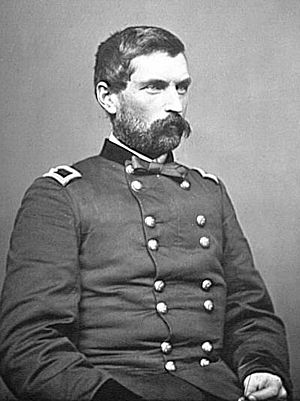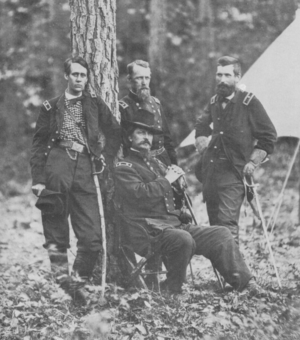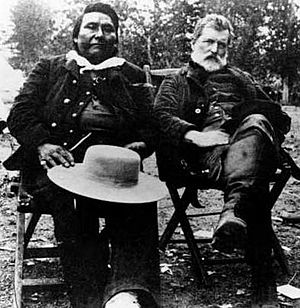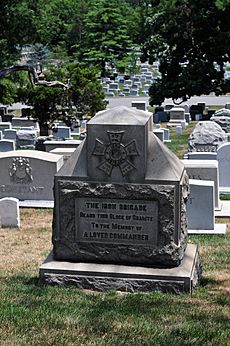John Gibbon facts for kids
Quick facts for kids
John Gibbon
|
|
|---|---|
 |
|
| Born | April 20, 1827 Holmesburg, Pennsylvania |
| Died | February 6, 1896 (aged 68) Baltimore, Maryland |
| Place of burial | |
| Allegiance | United States of America Union |
| Service/ |
United States Army Union Army |
| Years of service | 1847 – 1891 |
| Rank | |
| Commands held | XXIV Corps, Army of the James XVIII Corps Second Division, II Corps Second Division, I Corps Iron Brigade |
| Battles/wars | Mexican–American War Seminole Wars American Civil War
Nez Perce War |
| Relations | John Heysham Gibbon, (great-nephew) |
John Gibbon (born April 20, 1827 – died February 6, 1896) was a dedicated officer in the United States Army. He served in important conflicts like the American Civil War and the Indian Wars. His military career spanned over 40 years.
Contents
Early Life and Training
John Gibbon was born in Holmesburg, Pennsylvania. He was one of ten children. When he was almost 11, his family moved to Charlotte, North Carolina. His father worked at the U.S. Mint there.
Gibbon graduated from the United States Military Academy in 1847. He became a second lieutenant in the artillery. He served in the Mexican–American War, but did not see direct combat. He also helped keep peace between the Seminole people and settlers in Florida.
Later, he taught artillery tactics at West Point. In 1859, he wrote The Artillerist's Manual. This book was a scientific guide to using cannons. Both sides used it during the Civil War. In 1855, Gibbon married Francis "Fannie" North Moale. They had four children together.
Serving in the Civil War

When the Civil War began, John Gibbon was a captain in Utah. Even though some of his family members fought for the Confederate side, Gibbon stayed loyal to the Union. He became a chief of artillery for Maj. Gen. Irvin McDowell.
In 1862, he became a brigadier general. He commanded a group of soldiers from the western states. This group became known as King's Wisconsin Brigade. Gibbon trained his troops very well. He made them wear white leggings and special black hats. These hats earned them the nickname "The Black Hat Brigade."
His brigade fought bravely at the Battle of Brawner's Farm. This battle was a warm-up to the Second Battle of Bull Run. They also made a strong uphill charge at the Battle of South Mountain. Here, Maj. Gen. Joseph Hooker said they "fought like iron." From then on, they were called the "Iron Brigade." Gibbon led them at the Battle of Antietam. He even helped man a cannon during the intense fighting there.
In December 1862, Gibbon was promoted to lead the 2nd Division, I Corps. This was at the Battle of Fredericksburg, where he was wounded. He recovered and returned for the Battle of Chancellorsville in May 1863. His division was mostly in reserve during this battle.
At the Battle of Gettysburg in July 1863, he commanded the 2nd Division, II Corps. He even took temporary command of the entire corps. On July 2, army commander Maj. Gen. George Meade told Gibbon that if Lee attacked the next day, it would be right where Gibbon's troops were. Meade was right. Gibbon's division faced the main attack of Pickett's Charge on July 3. Gibbon was wounded again during this fierce fight.
After recovering, Gibbon returned to command the 2nd Division during Gen. Grant's Overland Campaign in 1864. He fought in battles like the Wilderness and Cold Harbor. In June 1864, he was promoted to major general of volunteers.
During the Siege of Petersburg, Gibbon briefly led the XVIII Corps. Then he took command of the new XXIV Corps. His troops helped break through the Confederate defenses at Third Battle of Petersburg in April 1865. They captured Fort Gregg. During the Appomattox Campaign, Gibbon helped block the Confederate escape route. This led to Gen. Lee's surrender at the Battle of Appomattox Court House. Gibbon was one of three officers who oversaw the surrender.
Battles in the West

After the Civil War, Gibbon stayed in the army. He became a colonel and commanded the 7th Infantry in Montana Territory. In 1876, he was part of the campaign against the Sioux. Gibbon, General George Crook, and General Alfred Terry planned to attack the Sioux together. However, General George Armstrong Custer attacked a large village too soon at the Battle of the Little Bighorn. Custer and many of his men were killed. Gibbon arrived the next day. His arrival likely saved the lives of other soldiers who were still under attack. He helped bury the dead and rescue the wounded.
The next year, Gibbon was still in Montana. He received orders to stop the Nez Percé people who were moving through the area. This led to the Nez Perce War. Gibbon found the Nez Perce near the Big Hole River. At the Battle of the Big Hole, both sides suffered many casualties. Gibbon himself was wounded. The Nez Perce eventually left the battlefield. General Oliver Otis Howard arrived to help Gibbon. Because of his injuries and losses, Gibbon could not continue chasing the Nez Perce.
Gibbon was a member of the Military Service Institution of the United States. He won an award for his essay called "Our Indian question."
Later Career and Retirement
In 1885, Gibbon was promoted to brigadier general in the regular army. He took command of the Department of the Columbia. This area included all military posts in the Pacific Northwest. In 1886, he declared martial law in Seattle, Washington during some anti-Chinese riots. This helped to restore order.
Gibbon retired from the army in 1891 when he turned 64. He had served for over 40 years. After retiring, he became president of the Iron Brigade Association. He also led the Military Order of the Loyal Legion of the United States.
Death and Legacy

John Gibbon died in Baltimore, Maryland, on February 6, 1896. He is buried in Arlington National Cemetery.
Besides his famous Artillerist's Manual, Gibbon also wrote books about his experiences. These include Personal Recollections of the Civil War and Adventures on the Western Frontier. He also wrote many articles about his time in the West and his thoughts on government policy toward Native Americans.
On July 3, 1988, a bronze statue of John Gibbon was placed in the Gettysburg National Military Park. It is near the spot where he was wounded during Pickett's Charge.
Several places are named after him, including the town of Gibbon, Minnesota, and Gibbonsville, Idaho. The Gibbon River and Falls in Yellowstone National Park are also named in his honor.


